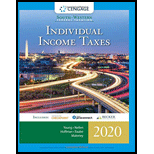
Individual Income Taxes
43rd Edition
ISBN: 9780357109731
Author: Hoffman
Publisher: CENGAGE LEARNING - CONSIGNMENT
expand_more
expand_more
format_list_bulleted
Concept explainers
Question
Chapter 2, Problem 1RP
To determine
Ascertain the missing data in these court decisions and rulings.
Expert Solution & Answer
Want to see the full answer?
Check out a sample textbook solution
Students have asked these similar questions
Please explain the solution to this general accounting problem with accurate principles.
XDR Industries products a single product. The company's absorption costing income statement for April is as follows:
Can you explain the correct methodology to solve this general accounting problem?
Chapter 2 Solutions
Individual Income Taxes
Ch. 2 - A large part of tax research consists of...Ch. 2 - Why do taxpayers often have more than one...Ch. 2 - Prob. 3DQCh. 2 - Prob. 4DQCh. 2 - Prob. 5DQCh. 2 - Prob. 6DQCh. 2 - Rank the following items from the lowest to...Ch. 2 - Prob. 8DQCh. 2 - Prob. 9DQCh. 2 - Prob. 10DQ
Ch. 2 - Prob. 11DQCh. 2 - Prob. 12DQCh. 2 - Sanjay receives a 90-day letter after his...Ch. 2 - Prob. 14DQCh. 2 - Prob. 15DQCh. 2 - Prob. 16DQCh. 2 - Prob. 17DQCh. 2 - Prob. 18DQCh. 2 - Prob. 19DQCh. 2 - Prob. 20DQCh. 2 - Prob. 21DQCh. 2 - Prob. 22DQCh. 2 - Prob. 23DQCh. 2 - Prob. 24DQCh. 2 - Prob. 25DQCh. 2 - Prob. 26DQCh. 2 - Prob. 27DQCh. 2 - Prob. 28DQCh. 2 - Prob. 29DQCh. 2 - Prob. 30DQCh. 2 - Prob. 31DQCh. 2 - For her tax class, Yvonne must prepare a research...Ch. 2 - Prob. 33DQCh. 2 - Prob. 34DQCh. 2 - Prob. 35DQCh. 2 - Prob. 36DQCh. 2 - Prob. 37PCh. 2 - Prob. 38PCh. 2 - Prob. 39PCh. 2 - Prob. 40PCh. 2 - Prob. 41PCh. 2 - Using the legend provided, classify each of the...Ch. 2 - Prob. 43PCh. 2 - Prob. 1RPCh. 2 - Prob. 2RPCh. 2 - When Oprah gave away Pontiac G6 sedans to her TV...Ch. 2 - Prob. 4RPCh. 2 - (1) Go to taxalmanac.org, and use the website to...
Knowledge Booster
Learn more about
Need a deep-dive on the concept behind this application? Look no further. Learn more about this topic, accounting and related others by exploring similar questions and additional content below.Similar questions
- Please explain the correct approach for solving this financial accounting question.arrow_forwardWhat price should sam pay for the bike if he think he can resell it for 9800 ? Solve ths general accounting questionarrow_forwardI need help solving this general accounting question with the proper methodology.arrow_forward
- Can you help me solve this general accounting question using the correct accounting procedures?arrow_forwardCan you explain the correct methodology to solve this general accounting problem?arrow_forwardI need help with this general accounting question using the proper accounting approach.arrow_forward
- Please explain the correct approach for solving this general accounting question.arrow_forwardKindly help me with this General accounting questions not use chart gpt please fast given solutionarrow_forwardI am trying to find the accurate solution to this general accounting problem with the correct explanation.arrow_forward
- I need help solving this general accounting question with the proper methodology.arrow_forwardPlease help me solve this general accounting problem with the correct financial process.arrow_forwardI need the correct answer to this general accounting problem using the standard accounting approach.arrow_forward
arrow_back_ios
SEE MORE QUESTIONS
arrow_forward_ios
Recommended textbooks for you
 Individual Income TaxesAccountingISBN:9780357109731Author:HoffmanPublisher:CENGAGE LEARNING - CONSIGNMENT
Individual Income TaxesAccountingISBN:9780357109731Author:HoffmanPublisher:CENGAGE LEARNING - CONSIGNMENT- Business Its Legal Ethical & Global EnvironmentAccountingISBN:9781305224414Author:JENNINGSPublisher:Cengage



Individual Income Taxes
Accounting
ISBN:9780357109731
Author:Hoffman
Publisher:CENGAGE LEARNING - CONSIGNMENT



Business Its Legal Ethical & Global Environment
Accounting
ISBN:9781305224414
Author:JENNINGS
Publisher:Cengage